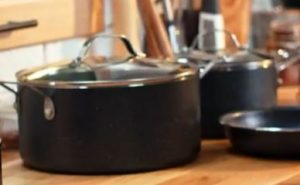You may be wondering what is Granitestone cookware made of and that’s a great question.
Granitestone cookware is made of natural stone. It is manufactured using advanced technology and is highly durable. It has a long lifespan and can be used for years without any major issues occurring. The material used in its manufacturing process is designed to ensure that it will not lose its effectiveness even after years of use.
Granitestone cookware is an excellent choice for those who are looking for a product that has a long lifespan, offers high-performance levels, and comes at an affordable price tag.
Is Granitestone a Teflon?
 Granitestone cookware is not made of Teflon. The only thing it has in common with Teflon is that it is non-stick. The material used in Granitestone cookware is a type of ceramic that is very durable and can withstand temperatures up to 500 degrees Fahrenheit.
Granitestone cookware is not made of Teflon. The only thing it has in common with Teflon is that it is non-stick. The material used in Granitestone cookware is a type of ceramic that is very durable and can withstand temperatures up to 500 degrees Fahrenheit.
It does not have the same chemical properties as Teflon, so you do not need to worry about it being damaged by your stove or oven. It also has an even heat distribution, which means that it heats evenly and efficiently, so you will get better results with fewer burns and splatters on your food.
What is Granitestone Cookware made of?
Granitestone cookware is made of the highest quality materials, which are then combined to create a sturdy and durable product.
The Granitestone cookware is made of stainless steel or aluminum, which means that it is not only safe to use but also very strong and durable. Stainless steel is incredibly strong and will hold up to high temperatures without warping or bending. The coating is also infused with diamonds for a tough finish.
The Granitestone cookware has a nonstick surface that makes cooking easier and more enjoyable. You won’t have to worry about burning food or having sticky messes on your countertop! The nonstick surface can be cleaned with simple soap and water, so you don’t need to buy special cleaners for it.
Is Granitestone cookware safe to use?
 Granitestone cookware is made of quartz, which is a type of stone. It’s a great material for cookware because it doesn’t absorb water or heat, so it won’t burn your food. This means that you can use your Granitestone cookware without worrying about ruining it by using too much heat or putting too much water in the pan.
Granitestone cookware is made of quartz, which is a type of stone. It’s a great material for cookware because it doesn’t absorb water or heat, so it won’t burn your food. This means that you can use your Granitestone cookware without worrying about ruining it by using too much heat or putting too much water in the pan.
Granitestone cookware is made from quartz, which is a type of rock. Quartz is a naturally occurring mineral that’s used in many different industries and can be found all over the world. One of the most common uses for quartz is to make quartz cookware, but you can find other uses for it as well.
Is Granitestone nontoxic?
Granite stone is non-toxic and is an extremely hard stone that has a variety of uses. It can be used for countertops, sinks, and even flooring. Granite is an excellent choice for kitchens because it provides a sleek look and resists stains, meaning you don’t have to worry about spills or accidents damaging your kitchen’s cleanliness.
Granite is also known for its durability and strength. This means that when you’re using your granite cookware, you can rest assured that it will last through years of use without cracking or breaking apart.
Is Granitestone Diamond toxic?
Granitestone cookware is made from a material called granite stone. It’s a porous stone, meaning it has holes in it that allow water to seep through and evaporate, keeping your food cool and fresh.
Granite stone is highly durable and can be used for decades without wearing down or cracking. It’s also non-porous, so it won’t absorb any flavors from the food you’re cooking on it.
Granite stone is not toxic to ingest, but it is toxic to touch so make sure you keep your hands away from it when you’re cooking!
What is the safest cookware for your health?
Granitestone cookware is made of a non-toxic ceramic material that can be used in the oven, microwave, and even on the stovetop. The material is a combination of quartz, aluminum oxide, and iron oxide. The cookware is safe for use with all kinds of foods including eggs, meat, and fish. It also does not contain any harmful chemicals like lead or cadmium which are often found in other types of cookware.
Granitestone has been used for decades by individuals who want to cook without worrying about their health or the health of those around them.
Is granite cookware better than non-stick?
Granitestone cookware is made of granite and quartz, a mixture of two minerals. The two minerals have different qualities, so they make different types of cookware.
Granite has lots of tiny pores that allow moisture to evaporate from food quickly, which makes it a good material for slow-cooking foods like soups and stews. Quartz, on the other hand, is more porous than granite and lets water vapor escape more quickly from the pan. That means your food will cook more quickly in quartz pans than in granite pans.
Both materials are nonstick which means they don’t need to be greased because they won’t stick to each other or your food. Granitestone cookware does have one advantage over nonstick. It has less acid content than other materials used for making nonstick cookware. This means that even if you use acidic ingredients like lemon juice or tomatoes with your meal (which can damage nonstick pans), you won’t have that same effect on Granitestone cookware.
Is Granitestone cookware durable?
Yes, Granitestone cookware is durable and it’s durable enough to last for generations! If you take care of your cookware, it will last a lifetime.
However, don’t be afraid to get creative with your cooking. If you’re using your cookware on the stovetop and accidentally cause some damage to it, call and they’ll send out a new replacement right away. Don’t worry about scratching or chipping the surface. The stone is easily repaired with one of the specialty products that can restore damaged areas without leaving any marks behind.
Are Granitestone pots and pans made well?
 Granitestone pots and pans are good for cooking. They’re even better than stainless steel and cast iron.
Granitestone pots and pans are good for cooking. They’re even better than stainless steel and cast iron.
Granite can withstand extremely high temperatures without melting or burning. This is what makes it so good for baking cakes and roasting meat. It’s also a great material for stir-frying because its heat retention properties allow you to cook at lower temperatures without ruining the food.
Granite is also naturally nonstick, which means that it allows food to slide off of it easily when you’re done cooking.
What is the best way to use Granitestone cookware?
Granitestone is a line of cookware that’s made of natural stone. It has all the benefits of porcelain and steel. It’s easy to clean, won’t rust, and is non-stick.
The best way to use Granitestone cookware is to heat it on the stovetop before you start using it. The flames will help to release any sticking substances that might be on the surface of your pan. The best way to get this done is by using a high-heat setting on your stovetop. Then wait for the pan to heat up before adding any food. You can also use the preheating function on your dishwasher if you have one just make sure that it’s set for “fast wash.”
Another great alternative is to place Granitestone cookware in a bowl of hot water for five minutes before using it, which will help remove any residue from previous uses or storage periods.
Can you use oil in Granitestone pans?
Yes, you can. There are two ways to do it:
- Use a non-stick cooking spray on the surface of your pan before adding food. This will prevent any oil from seeping into the pores of your pan, which could damage it.
- Use a high-heat oil such as canola or vegetable oil to cook your food in the pan. Wipe out any excess with paper towels so that you don’t have too much oil building up on the surface of your pan.
Is Granitestone cookware oven-safe?
Granitestone cookware is made of quartz, which is a crystallized form of silica. Quartz is extremely durable and has a high heat capacity, so it can withstand high temperatures without losing its shape or structural integrity.
Quartz is naturally non-porous, which means that it does not absorb moisture from water or other liquids. This makes it an excellent choice for use in the kitchen as well as the outdoors.
Quartz also happens to be one of the hardest materials available today, making it perfect for use in cookware.
How to clean your Granitestone cookware?
Follow these steps:
-Wipe down the cookware with a dry towel or cloth. Make sure that you clean off any food particles or spices that may have transferred onto the surface of your cookware.
-If there is any residue from previous use, sprinkle some salt on the surface of your cookware and rub it in with a dish brush until it starts to turn white. This will help remove any leftover food particles that are stuck to the surface of your cookware.
-Rinse off with hot water and let it air dry completely before using again!
How do you remove stains from granite cookware?
Stains on your granite cookware can be a real bummer. Luckily, there are some easy ways to remove them!
First, take a paper towel and apply dish soap directly to the stain. Then, rub it in until it’s gone.
If that doesn’t do the trick, try using vegetable oil instead of soap. Just pour some vegetable oil onto a paper towel and rub it into the stain until all of it has been removed.
Another option is to use lemon juice instead of dish soap or vegetable oil. Just cut open a lemon and squeeze out some juice into a bowl. Then mix in some sugar and salt until dissolved, then apply directly onto your stain with a toothpick or spoon (be careful not to let any get inside!). The acid in the lemon juice should help remove any stains from your granite cookware.
Conclusion
For a cookware set, Granitestone is not bad. It offers the basics – such as making the food non-stick, and it cleans easily. Also, it’s very durable, withstanding years of wear. The cons? Well, there are only two of them that we could find. First off, the temperature could be more even across the pan (and you might have to play around with some settings); second, it’s a little expensive, but at least it’s not outrageously expensive so I’ll let that slide.

